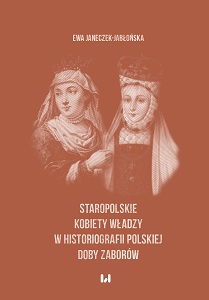Staropolskie kobiety władzy w historiografii polskiej doby zaborów
Old-Polish Women of Power in Polish Historiography of the Annexation Period
Author(s): Ewa Janeczek-Jabłońska
Subject(s): History, Local History / Microhistory, Political history, Gender history, Modern Age
Published by: Wydawnictwo Uniwersytetu Łódzkiego
Keywords: history of historiography; woman of power; historiography; historical synthese; annexation of Poland; late Enlighment; Romanticism; Posiitvism; Young Poland; Old-Polish women of power; saintly rulers; founders of the Church
Summary/Abstract: The book Old-Polish Women of Power in Polish Historiography of the Annexation Period contains the analysis on how the historians working in the years 1795–1918 displayed Polish female rulers, i.e. queens, princesses, wives and mothers of monarchs living from the beginning of the Polish state to the fall of the First Polish Republic. It shows how the women of power were evaluated by 19th century historians and what influenced their opinion. Ewa Janeczek-Jabłońska has analysed historical syntheses, articles and books written in the late Enlightenment, Romanticism, Positivism and Young Poland. Overall 12 historical syntheses and over 350 articles have been included in the research. Most numerous works on women of power were published in Romanticism. It matches the spiritual atmosphere of this culture formation. The portraits of women were enriched compared to the Enlightenment period. In historical writings of Romanticism wives of the Jagiellonian dynasty rulers were presented most often. In Positivism, more attention was paid to women of power from the Piast period who started getting more positive assessment. In the entire post-Partition historiography most works were devoted to Jadwiga of Poland, Marie Casimire d’Arquien and Barbara Radziwiłł. These three extremely different personalities show us the diversity of interests of the 19th century historians. The historians’ favorite women characters were usually saints or rulers of passionate and strong personality who had some influence on political events. There were substantial limitations of women’s influence on governing the country in the Old-Polish period. Ambitious female rulers who tried to influence public affairs were treated with reluctance by the Polish people. In over one hundred years of national servitude changes in the situation of Polish women occurred: they became more independent, the level of education of women raised. Nevertheless, the role models created by historians generally remained unchanged. The destiny of a woman had always been viewed in terms of being a mother, a good wife subservient to her husband. In historiography of Positivism and Young Poland, the revision in presentation of some women of power occurred, e.g. with regard to Bona or Richeza of Lotharingia. However, the general trends in assessment of spouses and mothers of Polish monarchs remain almost constant. Some Polish princesses and queens had their share in public life. They governed the country in the name of their children, led mediatory missions. A special role in the state was played by those ambitious women who had a husband under their command by either taking advantage of his weak character (Bona, Maria Louisa), or his feelings (e.g. Marie Casimire).
- E-ISBN-13: 978-83-8142-280-2
- Print-ISBN-13: 978-83-8142-279-6
- Page Count: 365
- Publication Year: 2019
- Language: Polish
- eBook-PDF
- Sample-PDF
- Table of Content
- Introduction

